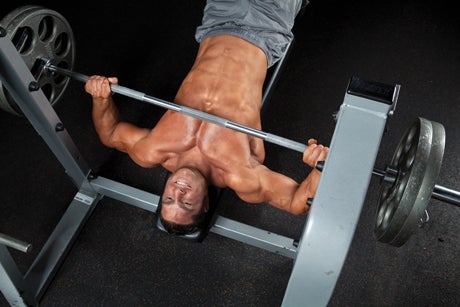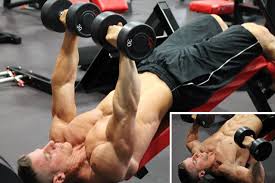The decline bench press is a good way to exercise the lower part of the chest muscles, and at the same time has a good exercise effect on the triceps and deltoid muscles.
Everyone knows that the chest is divided into upper, middle and lower parts. Have you found that if you fight with weight, the tablet can push the most, followed by the upper chest, and finally the lower chest?
Excluding the fact that most of the small partners rarely train the lower chest, you must find that when we perform the downward chest push because our feet are suspended in the air, it will reduce the stability and tightness in the bench press, which will hinder the transmission of power. , The requirements for stability are particularly high. On the contrary, this is not a bad thing. After all, stability is like a black hole for many novices. This is also one of the factors that we recommend you to do decline bench press.
Muscle exercise: Oblique push (and bird) exercises the pectoralis major, emphasizing the lower part of the muscles above the abdomen.
Features Of Decline Bench Press

The decline bench press is one of the variations of the bench press. The downward oblique angle can be used to turn the exercise center to the lower side of the pectoral muscles. At the same time, the downward oblique angle causes the bench press to shorten the range of motion, and the trajectory of the barbell is vertical. Possess certain mechanical advantages, allowing you to lift heavier!
How to Decline Bench Press?
Before you dive into the benefits of the decline bench press, first understand how to do it correctly.

Step 1
Set up a weight table that drops 30%. Larger declination may be too extreme. If possible, use a sloping stool with leg supports to fix your position.
Step 2
Lie on a bench and kick the dumbbells back with you, or ask the observer to give you the weight. Start by placing dumbbells on the outside of your upper chest.

Step 3
Push the dumbbell up, almost touching the top of the chest. Lower the dumbbells to the starting position in a controlled manner.
5 Decline Bench Press Benefits
1.Reduce pressure on shoulders, elbows and wrists
If you train more on the plank and incline, changing the angle of the bench press can help reduce the pressure on your shoulders, elbows and wrists. This can increase the amount of training without affecting the chest muscle training. This action has also been shown to reduce more low back tension than the flat bench press. For those who find that flat or inclined bench presses cause shoulder and back discomfort, the down bench press is a good choice.
2.Stimulate the lower part of the pectoral muscles

A decline bench press can stimulate the lower part of the pectoral muscles more than a flat board or an incline bench press. This makes it a good supplement to balanced chest exercises and helps weightlifters improve overall bench press and chest development.
According to a study by Glass et al. (1997), the downward oblique bench press has been shown to activate the lower chest muscles more, while still activating the upper chest muscles like other bench press changes. This suggests that if overall breast development is the main goal, then this may be your best bench press variant.
This is not to say that the lower pectoral muscles are not used at all during the horizontal or incline bench press, they are just not as important as they are during the descent. In addition, changing exercises and adding different training stimuli will contribute to the overall positive impact of muscle growth.
3.Fix unbalanced chest training
The decline bench press can also repair unbalanced chest training and stimulate those lacking training chest muscles. Exposing muscles to different angles of motion helps activate more muscles, stimulate new muscle growth, improve strength, and make muscles grow better and balance the symmetry of the chest muscles.
4.Able to lift more weight
Many weightlifters will notice that the incline bench press position allows you to move more weight compared to other positions.
Although a direct study on this has not been tested, a study indirectly found that the study participants were able to achieve the maximum number of repetitions of 1.25 times their body weight, and their 1RM of the uphill bench press was about 1.07 times their body weight.
Depending on your weightlifting history, this difference may be more or less obvious, but several weightlifters have rumored the same discovery. Therefore, if you are looking for a bench press variant that can use heavier weights, then the downward-incline press will be better than the upward-incline press.
5.Power transfer to arch bench press
A powerlifter with a large arch may find that the downward inclined bench press can be transferred well to their competition bench press because the angle and range of motion are similar.
When weightlifters produce a longbow, their chests are in a lowered position relative to the bench. That being said, if the weightlifter encounters problems on any part of the competition bench, the downward oblique press may be more suitable as an auxiliary tool to help them exercise more specific strength and hypertrophy without the need to implement the actual arch itself.
Disadvantages of Decline Bench Press
One disadvantage of the downhill bench press is that it can feel awkward, especially for those who have not done it before, and therefore may lead to less than ideal weightlifting mechanics.
Since your legs and torso are raised above your head, the lowered position will feel like the least "natural" position of your torso. Apart from the lowered position, there is no real leg drive to rely on in this variant, except for the leg locks to keep you in place.

Interestingly, I remember the first time I did the downward oblique press, I was hesitant to lower the weight because I thought it would fall directly on my face instead of my chest. Therefore, it may take some time to feel heavier.
That being said, it is strongly recommended to always have an observer with you, especially when you learn how to activate your chest muscles and move downward oblique presses in a more consistent manner.
Who should do the drop bench press?
The downhill bench press can be done by anyone, and bodybuilders, strength athletes, and everyday fitness enthusiasts may find that adding it to their plans has some benefits.
Bodybuilder
Bodybuilders are the group that can benefit the most from bench press, especially when breast development is their top priority. Although all the bench press variants can exercise the chest, the focus of the drop in the lower chest muscles, and does not put too much pressure on the shoulders.

Weightlifter and strongman
Powerlifters, especially those bench presses with obvious arches, may benefit from using the downward oblique press as an aid to competitive weightlifting.
Even if you are not a person who uses a high arch to push, the downward oblique bench press may be a good method. It can still add some heavier bench press to your week without adding extra to your back or shoulders. pressure.
From the perspective of muscular hypertrophy, strong men and weightlifters without obvious arches can also benefit from the downhill bench press. This is a great way to exercise your chest muscles, especially outside of the season.
Daily fitness enthusiast
Like a daily fitness enthusiast, you should be encouraged to try various types of weightlifting and variants to understand what you like and what helps you achieve your goals.
A decline bench press is great, especially if you find that lying or upside down bench press puts too much pressure on your shoulders or lower back, or if you want to give your chest a different type of stimulation to promote muscle growth.
Common mistakes
Bouncing the barbell bar from the chest: Usually, because we can add more weight than usual on the downhill bench press, the form and range of the action (the next point) are ignored and thrown out of the gym window. People often bounce barbells from their chests to add momentum to the increased resistance they push. This not only increases the possibility of sternum injury but also takes away any time under tension. Time spent in a stressful state stimulates breast growth. If you ignore this, you may forget that there is an opportunity for improvement in the breast area.
Lack of full range of motion: After this, when increased weight is added to the equation; the range of motion is often difficult to complete. This range of motion will not only produce intense tension on the pectoral muscle fibers; but it will also reduce the possibility of injury, help daily functions, and benefit the joints around the muscles. To prevent lack of range of motion, please choose a weight that can perform the entire concentric/eccentric motion throughout the process, if it helps, use an observer to correct your form/technique when needed.
Incorrect breathing methods: press exercises, such as shoulder press, bench press, military press and any other related exercises; when appropriate breathing methods are applied from beginning to end, the efficiency will be greatly praised. Correct breathing (centrifugal inhalation and centripetal exhalation) will not only improve exercise efficiency but also exert a greater force on typical different movements, as well as the interrelationship with the rhythm of the exercise itself. For example, take a deep breath for a slow, eccentric person, and a powerful exhale for a concentric person.
No Spotter: As mentioned earlier, and the exercise itself is in an unusual position; re-pull the barbell can be very embarrassing, especially in the case of muscle fatigue. Failure to re-elevate the weight safely will result in serious injury and may delay the sport for life! As you saw the benefits of the exercise in the previous article; it is safe to say that you don't want this to happen! To prevent this from happening, ask your training partner or anyone on the gym floor with good training knowledge (such as PT) to help you throughout the exercise, from the beginning to the end.
Read More:
Barbell bench press vs dumbbell bench press


